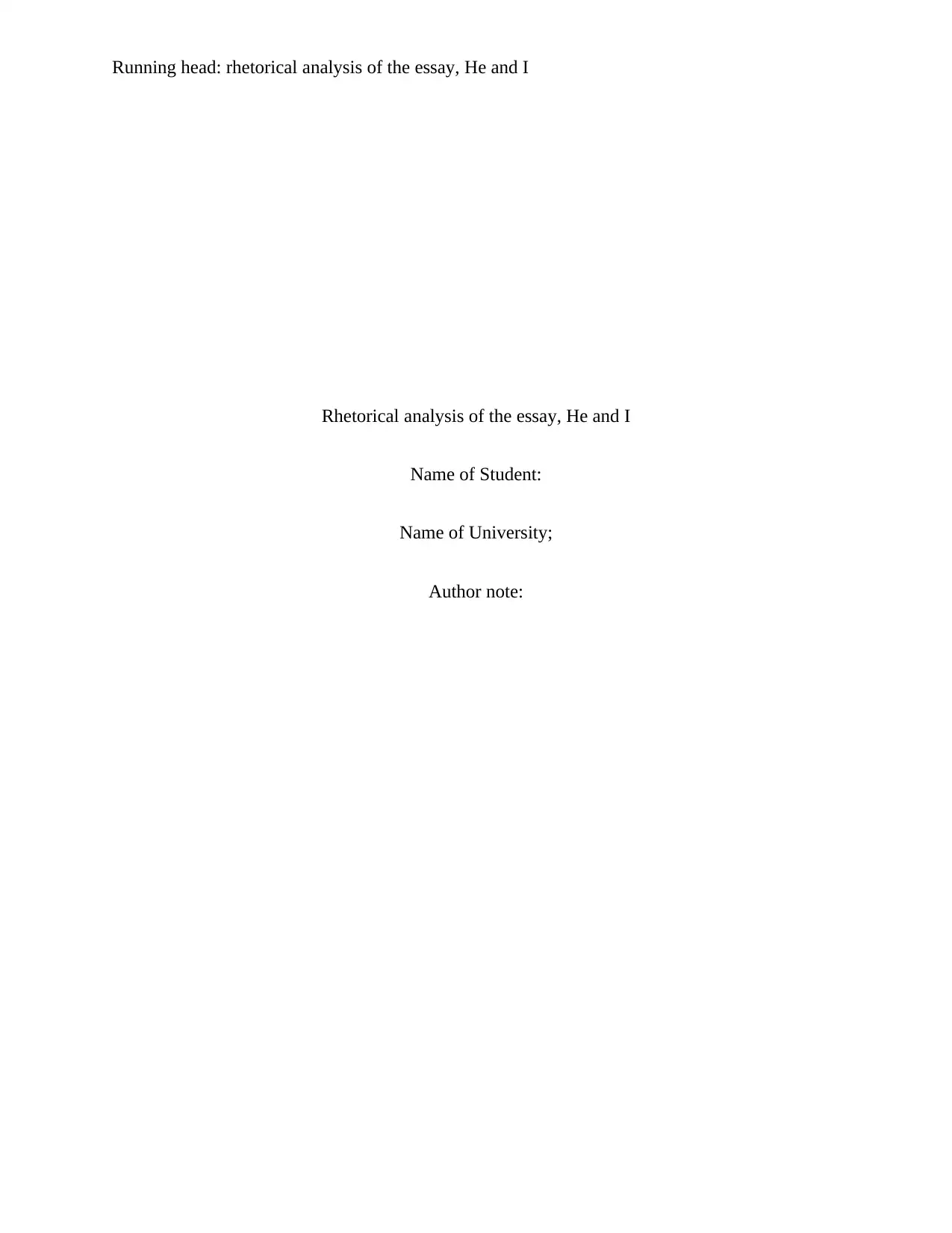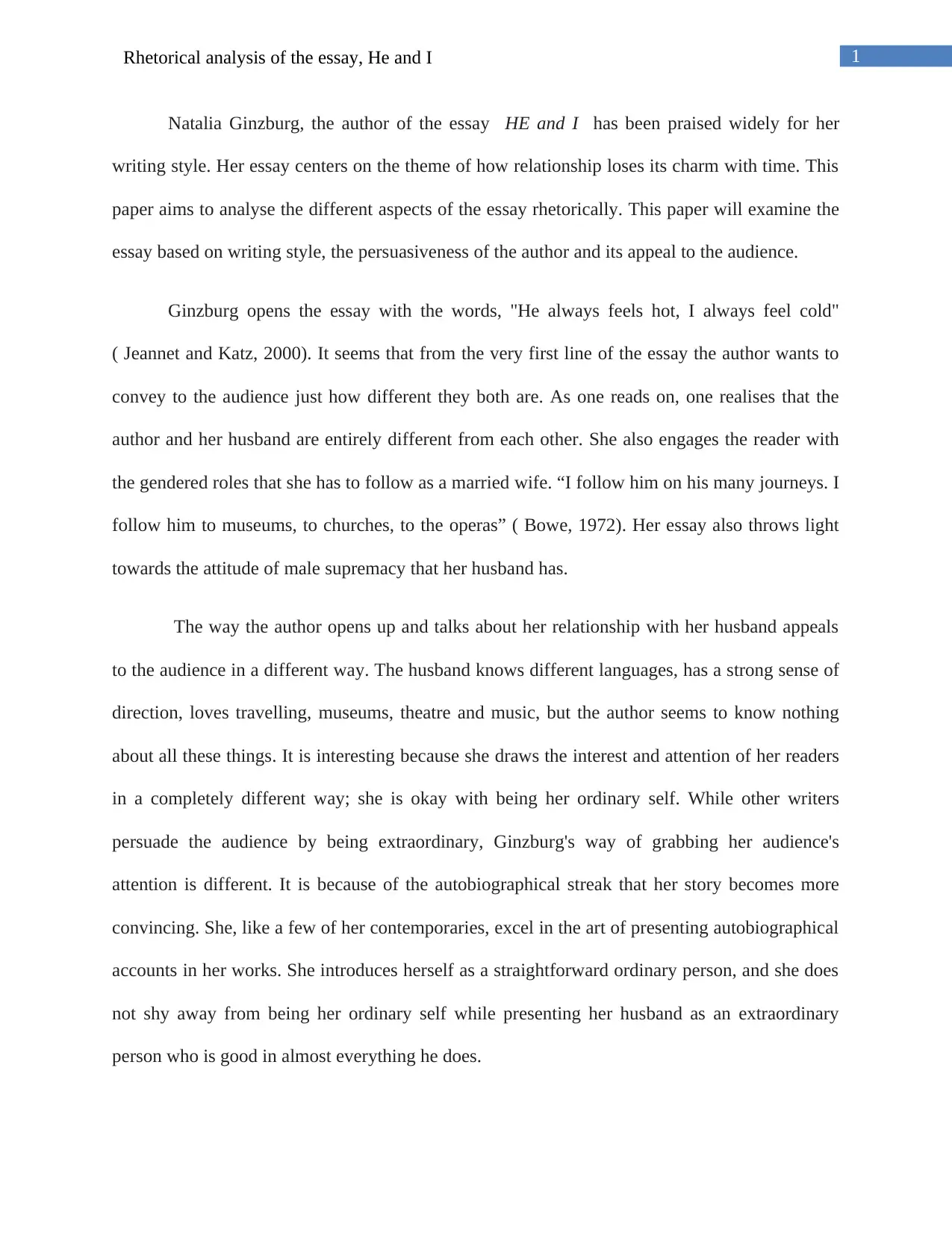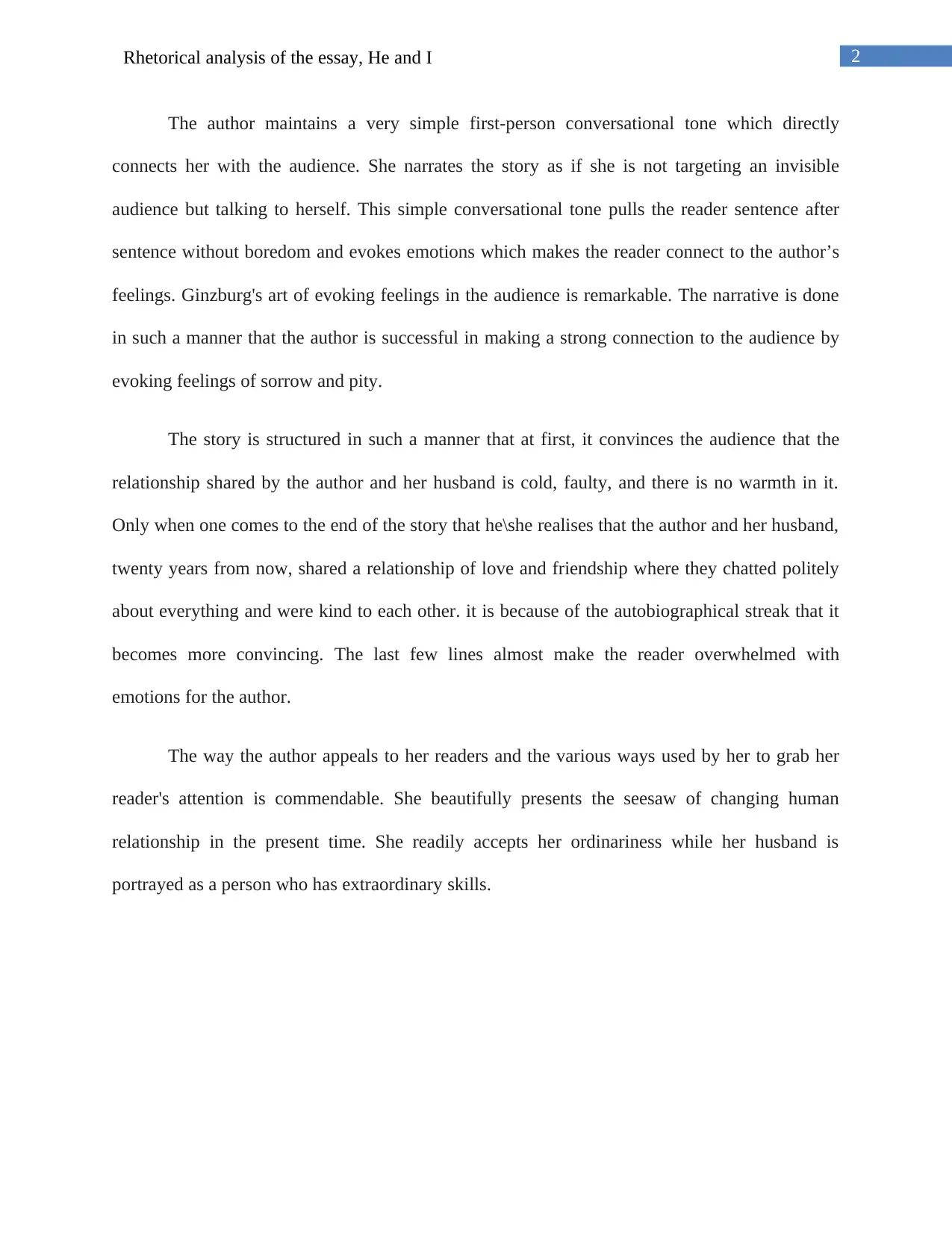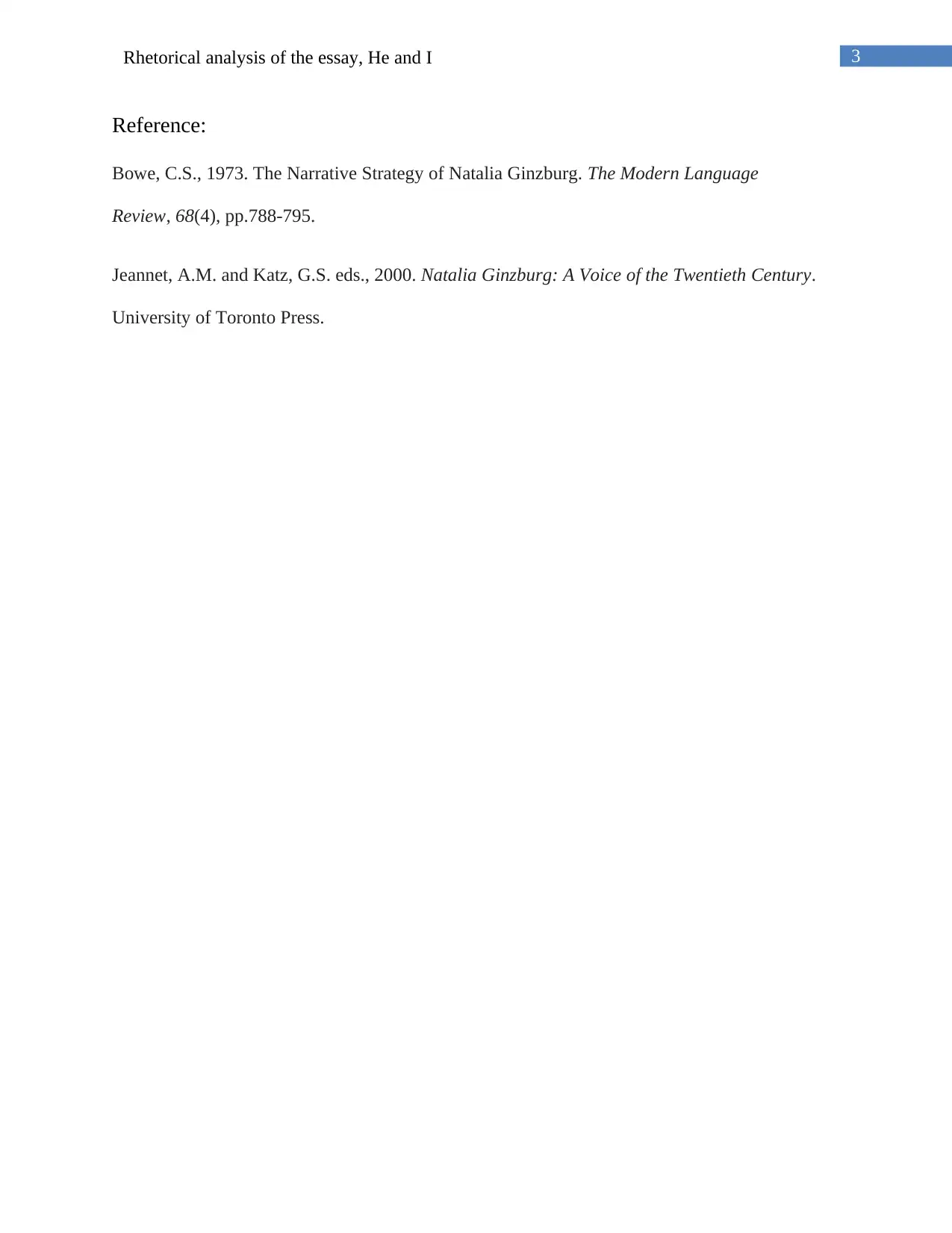Rhetorical Analysis of the Essay 'He and I' - University Assignment
VerifiedAdded on 2022/11/15
|4
|763
|96
Essay
AI Summary
This paper provides a rhetorical analysis of Natalia Ginzburg's essay, 'He and I.' It examines the author's writing style, persuasiveness, and appeal to the audience. The analysis explores the use of a simple, first-person conversational tone, autobiographical elements, and the structure of the narrative in evoking emotions and connecting with the reader. The paper highlights how Ginzburg presents herself as an ordinary person while portraying her husband as extraordinary, and how she effectively uses this contrast to engage the audience. The analysis also references the essay's theme of changing relationships and how the author's approach to the subject matter influences the reader's perception and emotional response.

Running head: rhetorical analysis of the essay, He and I
Rhetorical analysis of the essay, He and I
Name of Student:
Name of University;
Author note:
Rhetorical analysis of the essay, He and I
Name of Student:
Name of University;
Author note:
Paraphrase This Document
Need a fresh take? Get an instant paraphrase of this document with our AI Paraphraser

1Rhetorical analysis of the essay, He and I
Natalia Ginzburg, the author of the essay HE and I has been praised widely for her
writing style. Her essay centers on the theme of how relationship loses its charm with time. This
paper aims to analyse the different aspects of the essay rhetorically. This paper will examine the
essay based on writing style, the persuasiveness of the author and its appeal to the audience.
Ginzburg opens the essay with the words, "He always feels hot, I always feel cold"
( Jeannet and Katz, 2000). It seems that from the very first line of the essay the author wants to
convey to the audience just how different they both are. As one reads on, one realises that the
author and her husband are entirely different from each other. She also engages the reader with
the gendered roles that she has to follow as a married wife. “I follow him on his many journeys. I
follow him to museums, to churches, to the operas” ( Bowe, 1972). Her essay also throws light
towards the attitude of male supremacy that her husband has.
The way the author opens up and talks about her relationship with her husband appeals
to the audience in a different way. The husband knows different languages, has a strong sense of
direction, loves travelling, museums, theatre and music, but the author seems to know nothing
about all these things. It is interesting because she draws the interest and attention of her readers
in a completely different way; she is okay with being her ordinary self. While other writers
persuade the audience by being extraordinary, Ginzburg's way of grabbing her audience's
attention is different. It is because of the autobiographical streak that her story becomes more
convincing. She, like a few of her contemporaries, excel in the art of presenting autobiographical
accounts in her works. She introduces herself as a straightforward ordinary person, and she does
not shy away from being her ordinary self while presenting her husband as an extraordinary
person who is good in almost everything he does.
Natalia Ginzburg, the author of the essay HE and I has been praised widely for her
writing style. Her essay centers on the theme of how relationship loses its charm with time. This
paper aims to analyse the different aspects of the essay rhetorically. This paper will examine the
essay based on writing style, the persuasiveness of the author and its appeal to the audience.
Ginzburg opens the essay with the words, "He always feels hot, I always feel cold"
( Jeannet and Katz, 2000). It seems that from the very first line of the essay the author wants to
convey to the audience just how different they both are. As one reads on, one realises that the
author and her husband are entirely different from each other. She also engages the reader with
the gendered roles that she has to follow as a married wife. “I follow him on his many journeys. I
follow him to museums, to churches, to the operas” ( Bowe, 1972). Her essay also throws light
towards the attitude of male supremacy that her husband has.
The way the author opens up and talks about her relationship with her husband appeals
to the audience in a different way. The husband knows different languages, has a strong sense of
direction, loves travelling, museums, theatre and music, but the author seems to know nothing
about all these things. It is interesting because she draws the interest and attention of her readers
in a completely different way; she is okay with being her ordinary self. While other writers
persuade the audience by being extraordinary, Ginzburg's way of grabbing her audience's
attention is different. It is because of the autobiographical streak that her story becomes more
convincing. She, like a few of her contemporaries, excel in the art of presenting autobiographical
accounts in her works. She introduces herself as a straightforward ordinary person, and she does
not shy away from being her ordinary self while presenting her husband as an extraordinary
person who is good in almost everything he does.

2Rhetorical analysis of the essay, He and I
The author maintains a very simple first-person conversational tone which directly
connects her with the audience. She narrates the story as if she is not targeting an invisible
audience but talking to herself. This simple conversational tone pulls the reader sentence after
sentence without boredom and evokes emotions which makes the reader connect to the author’s
feelings. Ginzburg's art of evoking feelings in the audience is remarkable. The narrative is done
in such a manner that the author is successful in making a strong connection to the audience by
evoking feelings of sorrow and pity.
The story is structured in such a manner that at first, it convinces the audience that the
relationship shared by the author and her husband is cold, faulty, and there is no warmth in it.
Only when one comes to the end of the story that he\she realises that the author and her husband,
twenty years from now, shared a relationship of love and friendship where they chatted politely
about everything and were kind to each other. it is because of the autobiographical streak that it
becomes more convincing. The last few lines almost make the reader overwhelmed with
emotions for the author.
The way the author appeals to her readers and the various ways used by her to grab her
reader's attention is commendable. She beautifully presents the seesaw of changing human
relationship in the present time. She readily accepts her ordinariness while her husband is
portrayed as a person who has extraordinary skills.
The author maintains a very simple first-person conversational tone which directly
connects her with the audience. She narrates the story as if she is not targeting an invisible
audience but talking to herself. This simple conversational tone pulls the reader sentence after
sentence without boredom and evokes emotions which makes the reader connect to the author’s
feelings. Ginzburg's art of evoking feelings in the audience is remarkable. The narrative is done
in such a manner that the author is successful in making a strong connection to the audience by
evoking feelings of sorrow and pity.
The story is structured in such a manner that at first, it convinces the audience that the
relationship shared by the author and her husband is cold, faulty, and there is no warmth in it.
Only when one comes to the end of the story that he\she realises that the author and her husband,
twenty years from now, shared a relationship of love and friendship where they chatted politely
about everything and were kind to each other. it is because of the autobiographical streak that it
becomes more convincing. The last few lines almost make the reader overwhelmed with
emotions for the author.
The way the author appeals to her readers and the various ways used by her to grab her
reader's attention is commendable. She beautifully presents the seesaw of changing human
relationship in the present time. She readily accepts her ordinariness while her husband is
portrayed as a person who has extraordinary skills.
⊘ This is a preview!⊘
Do you want full access?
Subscribe today to unlock all pages.

Trusted by 1+ million students worldwide

3Rhetorical analysis of the essay, He and I
Reference:
Bowe, C.S., 1973. The Narrative Strategy of Natalia Ginzburg. The Modern Language
Review, 68(4), pp.788-795.
Jeannet, A.M. and Katz, G.S. eds., 2000. Natalia Ginzburg: A Voice of the Twentieth Century.
University of Toronto Press.
Reference:
Bowe, C.S., 1973. The Narrative Strategy of Natalia Ginzburg. The Modern Language
Review, 68(4), pp.788-795.
Jeannet, A.M. and Katz, G.S. eds., 2000. Natalia Ginzburg: A Voice of the Twentieth Century.
University of Toronto Press.
1 out of 4
Related Documents
Your All-in-One AI-Powered Toolkit for Academic Success.
+13062052269
info@desklib.com
Available 24*7 on WhatsApp / Email
![[object Object]](/_next/static/media/star-bottom.7253800d.svg)
Unlock your academic potential
Copyright © 2020–2025 A2Z Services. All Rights Reserved. Developed and managed by ZUCOL.





